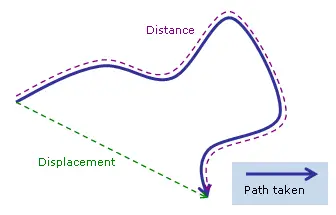Distance is the total path covered by a body during its motion and displacement is the shortest path covered by a body during its motion. Not to mention, both of them are used to specify the length between the two locations. However, they are totally opposite to each other.
In this exclusive article, we will talk about so many distance and displacement differences. But, before going into a deep discussion, let me give you a brief review of the two in a tabular form. Let’s dive right in…!!!
| Distance | Displacement | |
| 1. | Distance is the total path covered by a body during its motion. | Displacement is the shortest path covered by a body during its motion |
| 2. | Distance is a scalar quantity. It has magnitude but no direction | Displacement is a vector quantity. It has both magnitude and direction. |
| 3. | The S.I. unit of displacement is the meter. | It is not path-dependent i.e it does not change according to the path taken. |
| 4. | The value of the distance is always positive. | The value of displacement can be negative, positive, or even zero. |
| 5. | Distance never decreases over time. | In some special cases, displacement can decrease over time |
| 6. | It is denoted by “d”. | It is denoted by “s”. |
| 7. | The S.I. unit of displacement is meter. | It is path-dependent i.e. it changes according to the path taken. |
| 8. | The formula for distance is Distance(d) = Speed(s) × Time (t). | The formula for displacement is Displacement(s) = Velocity(v) ×Time(t). |
What is Distance?
By definition, Distance is nothing but the total path covered by a body during its motion. One can also say that the distance is the actual length of a path taken by a body from one point to another. See the image below for a proper understanding.

Simply speaking, it tells us how much of a path a body has covered during its motion. And, since it is a scalar quantity, therefore, as a result, to calculate distance, there is no need to consider the direction of its motion.
The S.I. unit of distance is a meter. And, it is denoted by “d”. Just because it is a scalar quantity, there is no need to indicate it with an arrow.
Editor’s Choice: Difference Between Uniform and Non-uniform Motion with Examples
Properties of Distance
There can be so many properties of distance. Some of them are listed below:
- Distance is a scalar quantity.
- Distance is path-dependent.
- The distance between two points is always positive.
- Distance is symmetric, etc.
What is Displacement?
By definition, Displacement is nothing but the shortest path covered by a body during its motion. One can also say that displacement is the shortest length of a path taken by a body from one point to another.
Simply speaking, it tells us how far out of place a body is from its original position. And, since it is a vector quantity, therefore, as a result, to calculate displacement, the direction of the motion has to be considered.
The S.I. unit of displacement is the meter. And, it is denoted by “s”. Just because it is a vector quantity, displacement is always indicated with an arrow.
Editor’s Choice: Distinguish Between Scalars and Vectors (Tabular Form)
Properties of Displacement
There can be so many properties of displacement. Some of them are listed below:
- Displacement is a vector quantity.
- Displacement is path-independent.
- The displacement between two points can be negative, positive, or, zero.
- Displacement is anti-symmetric, etc.
Editor’s Choice: Difference Between Speed and Velocity in Tabular Form
Frequently Asked Questions
1. How are distance and displacement related in physics?
Ans: Distance and displacement are both measurements used to quantify the extent of motion, but they convey different aspects of an object’s movement.
2. Can distance and displacement have the same numerical value?
Ans: Yes, if an object moves in a straight line, the distance and displacement can have the same numerical value.
3. Why is displacement considered more informative than distance in certain situations?
Ans: Displacement provides information about the change in position and direction, making it more informative, especially in analyzing motion.
4. Is distance a scalar or vector quantity?
Ans: Distance is a scalar quantity because it only has magnitude and no direction.
5. Can an object’s displacement be zero while its distance is not?
Ans: Yes, an object can return to its initial position, resulting in a displacement of zero even if the distance traveled is not zero.
6. How do distance and displacement impact navigation systems?
Ans: Navigation systems utilize both distance and displacement to provide accurate directions and estimate travel time efficiently.
7. In what scenarios is distance more relevant than displacement?
Ans: Distance is more relevant in situations where the actual path taken is crucial, such as tracking the total distance covered in a marathon.
8. Can an object have a negative displacement?
Ans: Yes, negative displacement indicates movement in the opposite direction from the reference point.
That’s it for this post. If you like this article, share it if you like, like it if you share it. You can also find us on Mix, Twitter, Pinterest, and Facebook. Hey man, If you have come this far, do give us feedback in the comment section. It would make my day. You can also make a donation. Your donations will help us to run our website and serve you BETTER. Cheers!!!
You might also like:
- Difference Between Kinetic and Potential Energy in Tabular Form
- Dot Product vs Cross Product (Tabular Form)
- Difference Between Mass and Weight (Tabular Form)
- Top 6 Uniform Motion Examples in SIX minutes (All NEW)
- Top 6 Non-uniform Motion Examples in SIX Minutes
- Difference Between Balanced and Unbalanced Forces (Tabular Form)
- Difference Between Periodic and Non-periodic Motion in Tabular Form

Very good